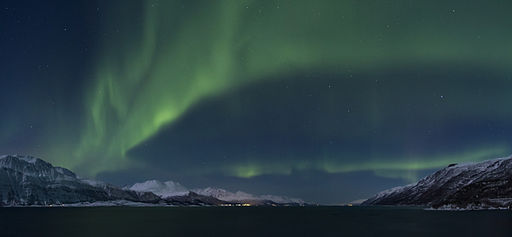
By Ximonic (Simo Räsänen) (Own work) [CC BY-SA 3.0], via Wikimedia Commons
The Aurora is one of the most beautiful phenomena in the solar system, and it is intrinsically linked to an elegant and ubiquitous process called Magnetic Reconnection. In this blog post I will describe magnetic reconnection, and discuss how it creates the Aurora. I’ll then show how we can do magnetic reconnection experiments on MAGPIE, and some of the work so far.
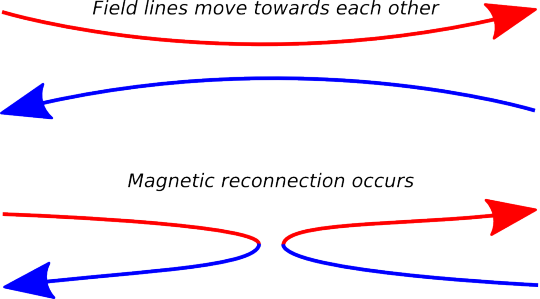
Magnetic reconnection occurs everywhere in the universe where magnetic fields meet, which is practically everywhere in the universe. Magnetic fields are embedded inside plasma, like string draped in thick treacles, and so as a plasma moves, the field lines are dragged along, sometimes becoming twisted and tangled. Unlike string, magnetic field lines have a clear direction, and when lines with opposite directions meet, magnetic reconnection occurs.
In magnetic reconnection, the oppositely directed field lines annihilate each other, converting the magnetic energy into heat and accelerating the particles in the plasma. The magnetic field lines reattach so that there are no loose ends – this is a topological change to the field, and it is profoundly important. This change in the magnetic field structure alters how the plasma can flow, because the plasma particles plasma move mostly along field lines.
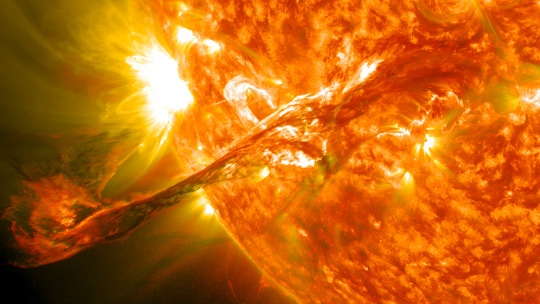
By NASA Goddard Space Flight Center – Flickr: Magnificent CME Erupts on the Sun – August 31, CC BY 2.0
How does magnetic reconnection cause the Aurora? The Aurora begins on the surface of the sun, where vast, twisting arches of plasma known as solar flares are formed. The arches rise buoyantly, like flames, and as they do so the magnetic field lines within them are stretched until the field lines at the base are oppositely directed. Magnetic reconnection snips off the field lines attaching the solar flare to the sun, suddenly launching the solar flare out into space as a blob of plasma. These blobs are known as Coronal Mass Ejections, and they move out through the solar system at speeds of thousands of kilometres a second.
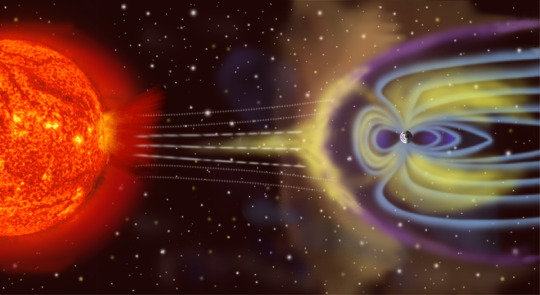
By NASA, Public Domain
Occasionally a Coronal Mass Ejection collides with the Earth. The Earth is protected from this searing ball of plasma by the magnetosphere, the magnetic field produced by the Earth’s core. The magnetosphere is one of the many things that most people are unaware they should be grateful for, but fortunately the magnetosphere insensitive to ingratitude. The magnetic field of the coronal mass ejection and the magnetosphere interact, undergoing further magnetic reconnection, and the coronal mass ejection flows around the Earth. As it flows around, it drags with it the Earth’s magnetic field, elongating it into a long tail the stretched behind the Earth.
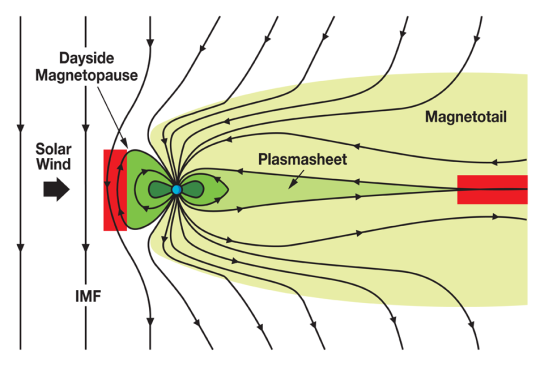
Reconnection occurs in the red regions. The Earth is the blue dot. By NASA, Public domain, via Wikimedia Commons
This long tail also undergoes magnetic reconnection as the stretched field lines are brought into contact. Magnetic reconnection heats and accelerated the particles in the plasma here, and the particles speed back towards to Earth. These fast move particles strike the Earth’s atmosphere at the poles, where most of the field lines originate, and cause the atmosphere glow with the characteristic green and red of the Aurora.
So to get an Aurora, we’ve had to invoke magnetic reconnection at least three times – firstly to pinch off a solar flare from the Sun an accelerate it towards Earth, secondly when the coronal mass ejection first hits the Earth, and finally behind the Earth to accelerate the particles to the poles and hence cause the atmosphere to glow.
In MAGPIE, we can generate streams of plasma that have embedded magnetic fields. By allowing two streams in which the fields are oppositely directed, we can trigger magnetic reconnection. We generate the streams using an ‘exploding’ wire array – a cylindrical shell made of thin rods or wires surrounds a thick central conductor. A large current from the MAGPIE generator passes up through the thin wires, turning them into plasma. The current returns to ground through the thick central conductor, which produces a large magnetic field that pushes the plasma outwards in every direction. The large magnetic field is embedded in the plasma, so as the plasma flows outwards it carries a magnetic field with it.
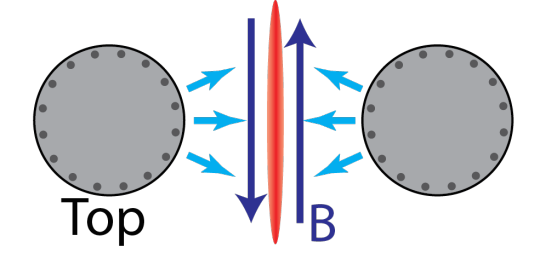
View of two exploding wire arrays from above. Light blue arrows indicate plasma streams, and magnetic reconnection takes place in the red region.
We place two of these exploding wire arrays side by side, so that the flows meet half way between them, and magnetic reconnection occurs. By choosing the material that the wires are made out of, we can change how fast the flows are and how the magnetic reconnection process takes place.
To study magnetic reconnection, it would be nice to observe the shape of the magnetic field lines, but this is difficult in our experiment. Instead we study how the plasma responds to the magnetic energy being released – it heats up and accelerates. Hot plasmas emit light just like a hot piece of metal does, and using a camera with a very fast exposure (five billionths of a second!) we can make movies of how the plasma responds. We can back this up by measuring the temperature and velocity of the plasma, as well as maps of the density. Our new Faraday rotation diagnostic allows us to measure magnetic fields and confirm that the magnetic fields are annihilated when they meet. This combination of qualitative and quantitative diagnostics allow us to make direct comparisons with theory and simulations.

An image take with a 5 ns exposure on a recent MAGPIE experiment, The bright regions are streams of plasma flowing towards each other. When they collide, magnetic reconnection should occur.
I’m just wrapping up a long experimental run on MAGPIE studying magnetic reconnection in carbon plasmas. Carbon is a interesting material to us because it appears to give plasmas which are hotter and carry larger magnetic fields than other materials. I won’t write about what we’ve found until we’ve had a chance to analyse the data and prepare it for publication, but I hope to write more about some of the theoretical foundations of magnetic reconnection in a blog post soon.
